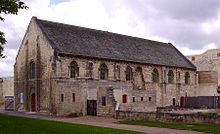Parlement of Rouen
This article includes a list of general references, but it lacks sufficient corresponding inline citations. (January 2017) |


The Parlement of Rouen (French: Parlement de Rouen), also known as the Parlement of Normandy (French: Parlement de Normandie) after the place where it sat (the provincial capital of Normandy), was a provincial parlement of the Kingdom of France. It replaced the ancient court of the exchequer of Normandy, set up by Rollo, first duke of Normandy.
The parlement was built in a mixing of the French
History

Raised to a sovereign court and given a base in Rouen by
When the court of the échiquier was made permanent, it was divided into two chambers, one to sit in the morning and the other in the afternoon. This second chamber later became known as the première des enquêtes. The chambre de la Tournelle, entrusted with criminal cases, was built in 1519 and the chambre des vacations was not set up until 1547. Until 1 October 1506, the parlement of Normandy sat in the
Many kings of France held
On 8 October 1550,
In 1523, Francis I exempted the parlement from the gabelle and ordained that it would issue to each of his officers and his widow as much salt as it had for his household, without fixing the quantity, paying only the market price, on the condition it did not abuse this privilege. In 1540 chancellor Guillaume Poyet set the king against the parlement de Rouen, and the king banned it. Commissaires were named for the Tournelle, and a president and 12 councillors sent to Bayeux, to give justice to the subjects of basse-Normandie until the king raised his ban; and wishing to give to this court's officers a mark of his satisfaction with their conduct, in June 1542 he made the arrière-ban exemption general and perpetual via an edict.
In 1560, the parlement of Normandy and the other provincial parlements were suppressed before being reestablished in June 1568 by
In April 1545, Francis I had set up a criminal chamber here to judge cases relating to Protestants, which was replaced by a chambre de l’édit, as part of the execution of the edict of Nantes of April 1598, suppressed in its turn in January 1685 as part of the edict of Fontainebleau. Made up at this time of 57 councillors and 2 presidents, an edict of July 1680 created a second chambre des enquêtes, after which the parlement was made up of five chambers, the grand-chambre, the Tournelle, two chambres des enquêtes and the chambre des requêtes du palais right up until the French Revolution. It was at the parlement of Normandy that, from 1728, the general assemblies of députés of different courts and other notables met to discuss public affairs such as hospitals' needs and other necessities.
Organisation

Notes
- ISBN 2-7242-0785-8) p. 367
Sources
- Encyclopédie ou Dictionnaire raisonné des sciences, des arts et des métiers by Diderot & d’Alembert, vol. 12, p. 60
References
- Amable Floquet, Histoire du parlement de Normandie, 7 volumes, Rouen, Édouard Frère, 1840–1842
- ISBN 2-86743-250-2
- (ed. Nicolas Plantrou), Du Parlement de Normandie à la Cour d'appel de Rouen 1499–1999, Rouen, 1999
